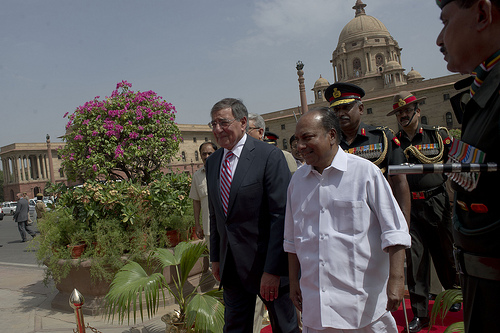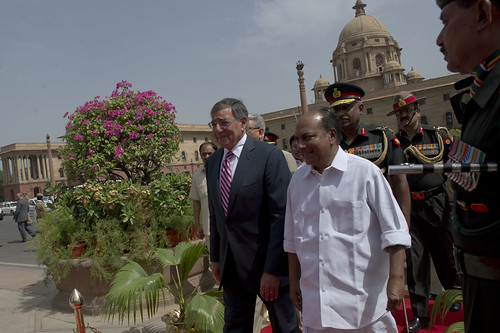
Indian-Chinese defense cooperation and U.S. interests

via Secretary of Defense
Following a high profile meeting between the Chinese and Indian defense ministers, both countries announced that they would further expand and deepen their defense cooperation, a move that further complicates the United States’ role on the continent. Concluding the meeting, Chinese Defense Minster Liang Guanglie announced that the two rising powers would resume joint military exercises as soon as possible. In addition, they will increase cooperation in areas of high level visits, officer exchange, and training.
India-China relations have been tumultuous in recent months, with both powers flexing military might to assert dominance in the region. Despite the announcement, no resolution was given to the primary friction point between the powers: the much disputed India-China border. The area, the site of a 1962 war, has remained contentious despite a 2005 treaty that sought to resolve the disputed boundary. China perceives recent moves by India, including an increased military presence and a controversial visit by India’s defense minister, as its attempt to contain China, and to assist in the U.S. ‘Asia Pivot’. The question then arises, how does renewed cooperation between the two giants affect U.S. interests in the region?
Following a non-alignment stance during the Cold War, India has found itself a key player and partner in the U.S.’s post-9/11 strategy. With Pakistan proving to be an incapable and often counter-productive ally in Afghanistan, India has readily stepped in, contributing economic and political aid to the Karzai government as a way to further assert India’s dominance in South Asia and to deprive Pakistan, an historical rival, of the ally it once found in a Taliban-controlled Afghanistan. Additionally, the U.S. has found itself a more-than-capable partner in fighting terrorism and has been providing assistance in India’s fight against terrorist organizations like Lashkar-e-Taiba, the perpetrators of the deadly 2008 Mumbai massacre.
With the ongoing drawdown of U.S. forces in Afghanistan, India once again finds itself with renewed prominence, this time as a counter-weight to China. In June, Secretary of Defense Leon Panetta went so far as to call India the “lynchpin” of the new U.S. military strategy, calling for further cooperation between the two countries. Additionally, the U.S. has been the primary beneficiary of India’s move to modernize the country’s armed forces, with few exceptions.
Strengthening ties between India and China is not in the U.S.’s best interest, but the recent news is hardly a sign that India is giving up on being a key security partner with the United States. Instead the move is a sign of both China and India’s desire to calm tensions leading up to the Chinese change in leadership, and to prevent more international tension following recent events in the South China Sea. Announcements of Indian-Chinese cooperation may not bode well for the United States’ hopes of a contained China, but at the heart of these talks is preventing armed conflict between the two superpowers, a power struggle that would be devastating for stability of the continent.
India’s breaks in its U.S. partnership are sure to arise in the future. India’s continued, albeit dwindling, reliance on Iranian oil is just one of many areas in which the U.S. and India will not see perfectly eye-to-eye. It must also be remembered that despite any military cooperation, India will still find itself competing with China in many arenas, preventing them from forming any serious partnership. Moreover, while the ‘Asia pivot’ is the future of U.S. strategy, it is far more important to recognize the problems we face now with a fledgling Afghan government and continually-volatile Pakistan. Any Indian break with the U.S. with regards to China is dwarfed by the country’s cooperation in working towards stability in South Asia. The U.S. must work around its differences with India to continue and expand their relationships and secure and stabilize the region.





